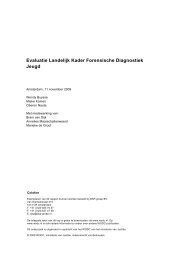Etniciteit en zorg rondom zwangerschap en ... - Rijksoverheid.nl
Etniciteit en zorg rondom zwangerschap en ... - Rijksoverheid.nl
Etniciteit en zorg rondom zwangerschap en ... - Rijksoverheid.nl
You also want an ePaper? Increase the reach of your titles
YUMPU automatically turns print PDFs into web optimized ePapers that Google loves.
Abstract<br />
Ethnic origin and care during pregnancy and birth: an exploration of Dutch research<br />
In g<strong>en</strong>eral pregnancy outcomes in non-western wom<strong>en</strong> and childr<strong>en</strong> in the Netherlands are less<br />
favourable as compared to the wom<strong>en</strong> and childr<strong>en</strong> of Dutch desc<strong>en</strong>t. Childr<strong>en</strong> belonging to an ethnic<br />
minority have on average a lower birth weight. Premature birth and birth defects occur more frequ<strong>en</strong>tly.<br />
Mortality around birth is less favorable in wom<strong>en</strong> and childr<strong>en</strong> of non-western ethnic groups.<br />
These conclusions can be drawn from differ<strong>en</strong>t studies into health differ<strong>en</strong>ces, and the underlying<br />
causes, in the Netherlands betwe<strong>en</strong> pregnant wom<strong>en</strong> and childr<strong>en</strong> of Dutch and those of non-western<br />
ethnic groups. In this report an overview is pres<strong>en</strong>ted of rec<strong>en</strong>tly finished and curr<strong>en</strong>tly ongoing studies<br />
that focus on differ<strong>en</strong>ces in pregnancy outcomes, in risk factors, in health care use and in use of<br />
prev<strong>en</strong>tive measures.<br />
The mortality differ<strong>en</strong>ces can partly be explained by differ<strong>en</strong>ces in known risk factors. Wom<strong>en</strong> from<br />
non-western ethnic origin are less familiar with prev<strong>en</strong>tive measures such as the periconceptional use<br />
of folic acid, have a late start in ant<strong>en</strong>atal care and use maternity care less frequ<strong>en</strong>tly. In this way they<br />
miss opportunities to be adequately informed about prev<strong>en</strong>tive measures they might take to promote a<br />
better health for their unborn childr<strong>en</strong> and themselves.<br />
The researches described in this overview offer starting points for improvem<strong>en</strong>t of pregnancy outcomes<br />
especially of wom<strong>en</strong> and childr<strong>en</strong> of non-western origin. Sometimes further research is needed to<br />
id<strong>en</strong>tify the causal pathways for the observed differ<strong>en</strong>ces and to indicate which culture-specific<br />
guidance or other prev<strong>en</strong>tive measures are needed.<br />
Reduction of perinatal health inequalities betwe<strong>en</strong> Dutch pregnant wom<strong>en</strong> requires an integrated public<br />
health policy. The fact is, part of these differ<strong>en</strong>ces in perinatal health outcomes are due to underlying<br />
mechanisms that lay beyond the scope of health care, such as a lack of flu<strong>en</strong>cy in the Dutch language or<br />
socio-economic inequalities.<br />
Key words:<br />
Perinatal mortality; maternal mortality; cot death; ethnicity; risk factor; health care utilization; health<br />
inequalities.<br />
RIVM Rapport 270032004 5









